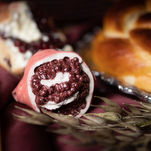New molds in production
- Kate Clarke

- May 27
- 3 min read
I've been busy in the studio the last week or so, making new molds. Some of my existing molds have been used for years now and the details wear away after time, but a few of my most used - crab claws, oysters, and asparagus - have had some accidental abuse in the studio, and need to be replaced asap. I still have a few molds yet to make (crab claws and asparagus!), but I've been diving deep into the details of some gnarly oysters and reveling in the textures of the Cajun culinary "Trinity and the Pope," ie celery, onion, and green pepper, plus garlic.
Here's the process of plaster mold making:
I choose the best and biggest examples of whatever I want to mold. Porcelain slipcasting shrinks a drastic 20% from real object to final firing, so I need to find big examples to use, in order to have a relatively normal sized cast.
I carefully plan out the mold dividing lines on the subjects. This involves using a set viewpoint to find the exact line where there is no "undercut" from that perspective. Most molds are only two parts, pulling away from each other and the cast from two opposite directions, but more complicated shapes like shells, the gator head, and even the curvaceous peppers, require 3 or more mold pieces. This is a super important step, because if I plan the line badly, the plaster might break off when releasing the original, or the porcelain casts will be stuck inside the mold.
I use reusable plasticine clay to build up a false floor around the objects, up to the division lines, and try to make the plasticine clay butt up against the subject in the most clean line possible. The sharper the abutment, the cleaner the casts will be, and the longer the mold will last.
Then I'm ready to pour the first plaster piece. I use wooden "cottles" to create a temporary box around the clay and subject, then pour plaster over. The plaster that I use is called Pottery Plaster #1, and it's formulated specifically for holding up to the challenges of slipcasting. It's much more durable than plaster of paris.
After the plaster has set up, I flip the whole thing over, and peel off the plasticine clay from the subject, now half submerged in plaster.
I treat the plaster with a very secret mold release: Murphy's Oil Soap for floors, which deposits a very thin layer of wax on the plaster, making it temporarily impervious to a new pour of plaster. Otherwise, the two pours will bond together, and my oysters would be permanently encased in plaster.
After cleaning up the edges and surface of the plaster, maybe using more plasticine to block off another section of the subject, it's time to pour more plaster. This is repeated until the subject is fully encased in separate plaster pieces. At this point, I carefully pry the pieces apart, hoping my planning paid off, and remove the original subject. If it's still edible I eat it. Mostly I don't. I still have to scrape away at sharp outer edges, wash off the mold release, and clean up the remaining undercuts or flaws in in the plaster, as well as drill/carve a sprue (the channel that slip is poured in/out of the mold).
The plaster takes at least a few days to cure, and reach it's target hardness/absorptive-ness, but I speed this along by keeping them in my kiln, programed to hold 125℉ for a few days. I usually can't wait for a week to cast them though, so a day or so later, I do a quick and dirty first cast. The first casts are unusable because they might have plaster crumbs imbedded or stick a bit to the plaster and rip. I just wanna see! It's so exciting to see that first cast... To see a perishable, soft object like strawberries or celery, for the first time in the cream monochrome of clay, is so cool.








































Comments